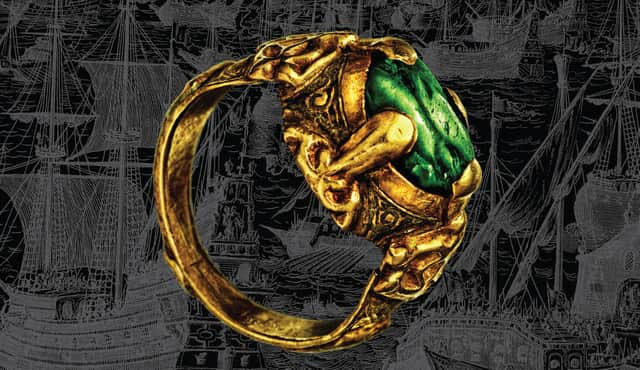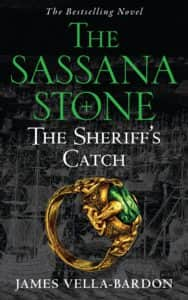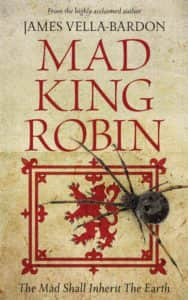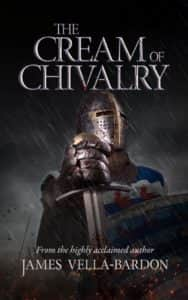Must-read of the week: The Sheriff’s Catch by James Vella-Bardon


This article contains affiliate links. We may earn a small commission on items purchased through this article, but that does not affect our editorial judgement.
Once every so often you encounter an author who, while not yet a household name, is certainly destined for greatness. Prodigious literary talent James Vella-Bardon is one such writer who, with his gripping debut novel The Sheriff’s Catch—an underdog adventure set during the late 16th century—has shown that he is well on the way to becoming the new king of historical fiction.
By Gwyneth Rees
For lovers of quality historical fiction, The Sheriff's Catch by James Vella-Bardon must surely be the next book they read—being a truly gripping and vividly told adventure.
Winner of the Best Novel and Best Historical Fiction categories at the prestigious International Royal Dragonfly Book Awards, the book is the first instalment in the author’s The Sassana Stone Pentalogy series.
Both this novel and the series as a whole recount the trials of fictional protagonist Abel de Santiago. Once a famed Spanish sniper, Santiago finds himself a fugitive on the run in 16th century Ireland after he is shipwrecked following the defeat of the Spanish Armada in 1588.
The story begins three years earlier, with Abel stationed in the village of Willebroek, in the Spanish Netherlands, where he forms part of Spanish King Philip II’s forces engaged in crushing a long-running Protestant rebellion.
He is but recently married to Elsien, the daughter of a local miller. Much to the anger of Elsien’s wealthy father, Abel has won his daughter’s heart. Elsien, who is pregnant with their child, reluctantly bids a temporary farewell to Abel as he marches off to ambush a mercenary force with his four comrades—Ramos, Salva, Gabri and Cristó.
Abel’s comrades are a vile and motley crew, described as “shabby street cats”, and having not been paid by the army for some two years. This deadly quartet have also been extorting Elsien’s father for protection money.
Abel hopes that his rapacious comrades will be able to take away prize money from an impending raid on the Protestant mercenary force, if only to quell their malicious threats towards his wife and father-in-law. However the attack does not go as planned, leaving Abel injured and abandoned.
After being rescued by Elsien’s brother, Maerten, Abel and his brother-in-law return home to discover a gross betrayal. For not only did his so-called comrades deliberately abandon him on the battlefield, they also returned to his wife’s village and set her house ablaze.


The scene where Abel finally returns to his wife’s home, only to find it a burnt-out shell, and soon after finding his wife, unborn child and father-in-law dead—having succumbed to the toxic smoke of the fire—is heart-breaking.
No sooner has he said his goodbyes than an enraged Maerten is arrested by a Spanish patrol, forcing Abel to choose between his nation and his family by marriage. With a blast of his rifle, his choice is made and he suddenly finds himself an enemy of the Spanish army he had served loyally for decades.
Grief-stricken, Abel and Maerten then begin a two-year-campaign for revenge, pursuing the murderous men responsible for Elsien’s death across Spain. Eventually tracking them down in Seville, they launch their attack but are betrayed once more when their hiding place revealed.
Forced into slavery, they end up aboard the Spanish Armada, where the next stage of Abel’s adventure unfolds. Washing up on the coast of Ireland after his ship goes down during a brutal storm, Abel is captured by the sheriff of Sligo, who is acting on orders from Dublin to round up and dispose of any Spanish castaways.
Abel daringly manages to escape torture and certain death, taking with him a priceless emerald ring which—unknown to him—possesses far greater significance than just its value.
Once again on the run across the wilds of Ireland, he saves the life of a revered Irish poetess whose husband is killed by the sheriff’s men during a vicious night raid.
Bonded by their sense of loss, they will be pushed to the limits of endurance and cunning as they flee across a strange and dangerous land in a quest to reunite Muireann with her only son.
The Sheriff’s Catch is one of those rare novels that hits all the right notes, and within the space of just a few chapters you can understand why it has been showered with literary accolades.
Gripping, vivid historical fiction told from an unfamiliar perspective, the book is packed with characters with complicated relationships, and filled with difficult human emotions, such as greed, envy, lust and revenge.
Abel is the perfect protagonist to take you on this journey. A man of action, defined by his bravery and sense of honour, he is nevertheless human and subject to the same fears and doubts as anyone else beneath all his battle scars.
While I lapped up his many fights and skirmishes, it was those moments where his humanity shone through that stood out for me, such as when, left abandoned by his comrades, he is racked by feelings of terror:
I shivered upon hearing the sudden sound of hooves, and my skin crawled at the thought of an approaching band of Protestants. I rolled over behind a tree, afraid that they might discover me, before nailing me to the closest tree or beating me to death….
Another instance is when he is in Ireland, again hiding—sometimes amidst excrement and offal—to escape men intent on seeing him dead.
What’s more, the charged storyline—that sizzles with all the potency of lit gunpowder— presents a stunningly evocative sense of period.


Author James Vella-Bardon, originally from Malta but long resident in Australia, is both meticulous and judicious in detailing 16th century life, from the sparkling language and lucid descriptions to the political and religious conflicts that underpins all that takes places.
This, however, is never overbearing. You come away knowing so much more about the era yet are always propelled forward by the fast-paced, action-packed plot, where jeopardy is ever-present.
The scene in Seville, where the “pox” is present and the “sounds of the groaning dying emanating from within boarded-up houses” was particularly memorable, as was the scene when the English attack the Spanish Armada, firing their canons into the boats’ flanks.
This is all the more interesting given that we are told this from the perspective of a Spanish soldier, the ‘enemy’.
This championing of the outsider seems to be something of a trait of Vella-Bardon’s writing, as his latest novel—Mad King Robin—also features an underdog protagonist fighting against huge odds.
A standalone historical adventure set at the beginning of the 14th Century, it focuses on Robert the Bruce’s bid to free Scotland from the yoke of English rule.
Both novels, then, bear the same authorial hallmarks and display the same, impressive level of historical exactitude. Indeed, with Mad King Robin, Vella-Bardon spent close to a decade researching the period before crafting his tale.
This remarkable dedication to his craft has led him to becoming known as a virtuoso author of historical fiction, having been a finalist in the Wishing Shelf Independent Book Awards, Eric Hoffer Awards and the Independent Author Network Book Awards, where he was named a finalist in the ‘Outstanding Historical’ category.
And this same prodigious talent has resulted in him finding a new home with publishing company Tearaway Press, which has been created especially by one of the author’s many fans, respected Australian investment manager Anton Tagliaferro, for the sole purpose of publishing and promoting Vella-Bardon’s books more widely.
It is thanks to Tearaway Press that The Sheriff’s Catch, originally released in 2018, has come to be republished, and which will be followed by the four remaining books in The Sassana Stone Pentalogy: A Rebel North, Hero of Rosclogher, Trials In Tumult and Ring Of Ruse.
Tagliaferro believes that James Vella-Bardon has what it takes to become a literary giant, and on the basis of The Sheriff’s Catch I wholeheartedly agree.
His command of the written word and the crafting of historical fiction that entertains and informs in equal measures reminds me of works by today’s masters such as Bernard Cornwell, Conn Iggulden and Wilbur Smith.
The most exciting thing is that he is still early into his writing career, with many more incredible stories to share for our pleasure.
And as an added bonus, he is prodigious in his output. The Sheriff’s Catch alone clocks in at over 400 pages and his website is currently spoiling new newsletter subscribers with a free story - an exclusive tale called The Cream of Chivalry, which falls under the category of ‘short story’ but is as densely packed with historical intrigue and thrills as many other authors’ full-blown novels.
So, while you may not have been familiar with his name before today, I have no hesitation in predicting that James Vella-Bardon is destined to become the future king of historical fiction.
The Sheriff’s Catch is, simply put, a stunning work from an equally stunning up-and-coming writer who has more than earned the right to a global readership.
The Sheriff's Catch by James Vella-Bardon is out now on Amazon, published by Tearaway Press, priced at £10.71 as a paperback and £2.30 as an eBook. An audiobook adaptation of The Sheriff's Catch will be released on 15th July, priced £12. Mad King Robin is also available on Amazon, priced at £10.20 for paperback, and £2.35 for eBook. For more information, visit www.jamesvellabardon.com
Q&A interview with James Vella-Bardon
We speak to award-winning historical fiction author James Vella-Bardon about his stunning new novel, The Sheriff’s Catch, his writing career, and why stories from the perspective of the underdog are not only intriguing but necessary.


Q: What inspired you to become an author?
A: The urge to write has always been there. When I was six I turned to my cousin and told him, ‘let’s write a book.’ He drew the pictures and I wrote the story: it was about a man who built a spaceship in his backyard and travelled to the moon.
But where does my innate, overwhelming urge to write come from? The best explanation I heard for the writing bug comes from the ancient Greeks and Romans, who believed that creativity was a deity called a ‘daemon’ or ‘genius’; a divine attendant spirit that comes from a distant and unknowable source and picks a human being as its medium. I would best describe it as this intermittent whisper in my ear, followed by an overwhelming urge to write down what I hear. It’s a condition, or even an affliction, if the whispers begin in the middle of the night! I find myself overwhelmed by all these ideas and stories about history. It’s a curious condition.
It can sometimes make things a bit challenging. But then you get these great moments as an author which make it all worthwhile For example, I recently listened to the audiobook of my debut, The Sheriff’s Catch, which is set to be released in July. It is read by the UK’s leading voice actor, Jonathan Keeble, and I cannot tell you what an amazing job he did with capturing my characters’ mindsets with his tone and the justice he rendered to the prose which I took so many hours to create and edit. It’s moments like that which make perfect sense of what the inspiration (or the daemon’s whispers) is about: to entertain people by recounting stories of protagonists fighting their way out of a particularly tumultuous and interesting period of history.
Q: Your novels are noted for featuring an underdog protagonist and reflecting history ‘from the other side’. Can you explain why telling the underdog’s story is more compelling for you?
A: Humanity has always been intrigued by stories about protagonists who unexpectedly defy the natural or expected order of things or test the boundaries. So, for example, in The Sheriff’s Catch I delve deeply into how some survivors of the Spanish Armada shipwrecks, who were all thirsty and starving, managed to defy the odds by eluding their Sassenach aggressors through sheer grit and ingenuity. In my recently published thriller Mad King Robin, I reveal the tactics employed by Robert the Bruce at the battle of Bannockburn, despite being vastly outnumbered, to achieve the unthinkable.
These are examples of what an underdog does: when all logic and reason dictates that an underdog should lose, the very opposite happens, and I suppose that that intrigues people. It’s been that way since the David vs Goliath story in the Bible, plus you can see all the fascination right now in the Western media of a smaller Ukraine reportedly outwitting and outfoxing a huge, terrifying adversary. The ‘how’ behind these exploits generally points to ingenuity or exceptional tenacity on the part of the underdog. We humans know that that ingenuity is what placed us on top of the food chain on this planet, despite there being other creatures far stronger or quicker than us.
As for my stories reflecting history ‘from the other side’, I think it is intellectually stimulating to understand the less-told side of the story in history. Much as I love English literature, it is so easy to fall into an Anglocentric perception of world events, as well as to split things into good vs evil or black and white. One cannot truly have a proper appreciation of history without understanding the various civilisations that dominated Europe and the world, and the Spanish Empire was after all ‘the empire on which the sun never sets.’ There were so many peoples and cultures and stories within it, many of which are so intriguing and vivid and colourful, that it seems a shame to simply dismiss it so lightly. This is also true of the Irish tribes which also feature in The Sheriff’s Catch, who were often dismissed as ‘savages’ by both the Spaniards and the English, when in truth they were a highly sophisticated and extremely interesting civilisation.
A story about the other side is also a fresh and original take, which broadens our understanding about an event that we thought we knew well.
Q: You are a prolific author, being known to write as much as 2,000 words a day, all the while holding down a demanding job and having a young family. How do you do it?
A: I, myself, sometimes wonder how I manage to pull it off. But you have to understand that it’s this huge love of history and wanting to share my enthusiasm and knowledge with others that gives me this inexplicable source of energy to write at night. How can I not be motivated to share the incredible challenges which were faced by the crews aboard the ships of the Spanish Armada, who encountered the most freakish and outlandish storms in the middle of a European summer on their way to England?
That said, it is not always easy balancing writing with a full-time job and a young family. But then I suppose nothing worthwhile ever is. It requires strict time management as well as a lot of sacrifices. But I love writing and sharing my ideas in the books I write—it’s my passion!
Q: What research did you do when writing The Sheriff’s Catch?
A: I spent years carrying out research at the Fisher Library at The University of Sydney, a world-class library that is very well-stocked, and I read everything from the accounts of English annalists during the 16th Century to the studies of Irish nationalists like Alice Stopford Green. I employed a journalistic approach when researching the period, making sure to read English, Irish, Spanish and all other available records about the Spanish Armada and the shipwrecks in Ireland to create as objective a picture as I could in my mind. I was not only reaching material about the Armada, but also about Irish culture, geography, English colonialism, the evolution of Irish tribes due to the Tudor reconquest and many other areas.
I have experience carrying out research at this level, because I have a Doctor of Laws degree obtained from the University of Malta. However I’m not exaggerating when I tell you that the amount of research I carried out to write The Sheriff’s Catch and its four sequels was at least the equivalent of four times the amount of research required for a doctoral thesis!
Besides reading all the sources I could find by historians and academics, I also spoke to all kinds of wonderful people outside academia. These included historical reenactors who dress as Spanish tercios, Irish kerns or Scottish gallowglasses, as well as people who build 16th century firearms from scratch. In this way I was able to pick out the errors made by academics, and better determine the truth when I came across conflicting accounts.
It is important to go the extra mile to better understand your subject, which is why I travelled to western Ireland in October 2012 to visit the beaches where the Spanish Armada’s ships were wrecked as well as the places where the Spanish castaways travelled through after landing in Ireland. In the process I got to meet many interesting locals who consisted of academics and reenactors, who were very generous with their time and provided me with additional insights which I used in the book.


Q: What is the key ingredient to a good work of historical fiction?
A: I think the key ingredient remains the story. It is often very tempting, as a historical novelist, to get too wrapped up in the history and stray from the human story you are trying to tell. Every story, regardless of its genre, must contain a central theme that the historical setting serves to amplify. That said, you do get writers like James Michener or Edward Rutherfurd who have made a decent career out of using their characters to reveal centuries of history.